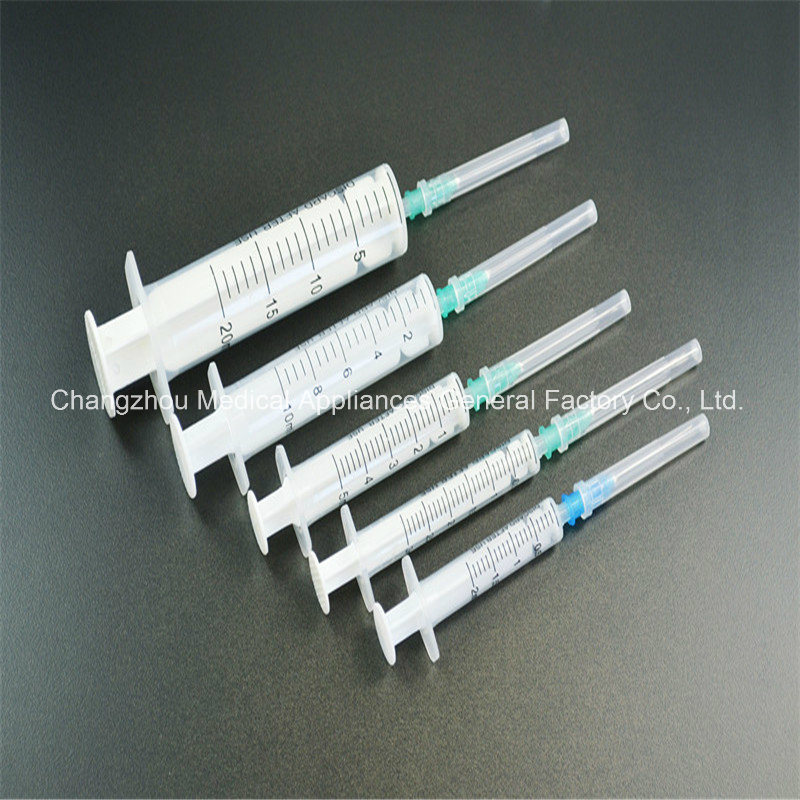Model NO.: 2ml, 5ml, 10ml, 20ml
Group: Adult or Children
Needle: with or Without Needle
Syringe Use: Intramuscular Injection
Disinfection: Disinfection
Size: 2ml, 5ml, 10ml, 20ml
Parts: 2-Parts
Luer Type: Luer Slip and Luer Lock
Sample: Free
Trademark: Lelun or OEM
Transport Package: PE and Blister
Specification: ISO, CE
Origin: China
HS Code: 90183100
Model NO.: 2ml, 5ml, 10ml, 20ml
Group: Adult or Children
Needle: with or Without Needle
Syringe Use: Intramuscular Injection
Disinfection: Disinfection
Size: 2ml, 5ml, 10ml, 20ml
Parts: 2-Parts
Luer Type: Luer Slip and Luer Lock
Sample: Free
Trademark: Lelun or OEM
Transport Package: PE and Blister
Specification: ISO, CE
Origin: China
HS Code: 90183100
Disposable syringes:1. Two parts
2. The PE or Blister individual package
3. The PE or Box secondly package
Material:
1. Barrel
Material: Medical and high transparent PP with Plunger stopped ring.
Standard: 2ml 5ml 10ml 20ml
2. Handspike
Material: Medical and high transparent PP
Standard: According to the size of barrel.
3. Needle
Material: Stainless steel AISI 304
Diameter and length: According to ISO standards 9626
4. Needle Protector
Material: Medical and high transparent PP
Length: According to the length of needle
Lubricant Medical silicone (ISO7864)
Scale indelible according to the ISO standards

 Disposable syringes:
1. Two parts
2. The PE or Blister individual package
3. The PE or Box secondly package
Material:
1. Barrel
Material: Medical and high transparent PP with Plunger stopped ring.
Standard: 2ml 5ml 10ml 20ml
2. Handspike
Material: Medical and high transparent PP
Standard: According to the size of barrel.
3. Needle
Material: Stainless steel AISI 304
Diameter and length: According to ISO standards 9626
4. Needle Protector
Material: Medical and high transparent PP
Length: According to the length of needle
Lubricant Medical silicone (ISO7864)
Scale indelible according to the ISO standards

Â
Green Tea Processing
Steaming, Roasting, Baking
Chinese and Japanese green tea processing uses 3 firing methods. What are the advantages and disadvantages of each?
Unlike Black Tea, green tea is made with minimal oxidation. A process - called firing - applies high heat to kill the leaf enzymes to stop oxidation on its track, which resulted in the high catechins content of green tea.
The three firing methods account for the infinite varieties of green tea that exist in China and Japan today. All three methods were originally developed by the Chinese, as it long history affords it time to experiment and innovate.
Steaming

Steaming was widely used in Chinese green tea processing until the 16th century. It has regained popularity in recent years, especially for export to Japan.
Early Tribute teas were steamed. Japanese monk Kobo Daishi learnt this when he visited China in A.D. 804 and introduced tea drinking to Japan with the Chinese tea seeds he brought back. Today, the majority of Japanese green tea is steamed.
Advantages: Attractive "three greens": dried leaves, brewed liquor and brewed leaves.
Disadvantages: May smell grassy and taste bitter.
Roasting

Today, roasting or pan-firing is the most popular firing method for Chinese Green Tea. Like stir-frying Chinese food, the traditional handicraft uses an iron wok on a hot stove.
It was preferred over steaming for 2 reasons: it is quicker to roast and it smells better.
Using several distinct hands movements, a skillful roaster is able to handroast leaves into many different shapes using their bare hands. It is an incredible art form.
The three broad categories are long-roasting (Mei Cha), round-roasting (Zhu Cha or gunpowder green tea) and flat-roasting (Longjing tea, Da Fang tea).
Both Meicha (Hyson) (and Zhucha (Gunpowder) use mature leaves for processing and were developed for export to the Western world.
Advantages: Rich nutty aroma. Stunning varieties of shapes.
Disadvantages: Yellowish green coloration. Very brittle. May be fragmented, burned.
Baking
 Baking can be done using either a charcoal or an electric oven. It is preferred over roasting when it is important to preserve the shape and texture of the pre-processed tea, such as when making jasmine scented green tea.
Baking can be done using either a charcoal or an electric oven. It is preferred over roasting when it is important to preserve the shape and texture of the pre-processed tea, such as when making jasmine scented green tea.
Floral and fruity green tea is usually baked rather than roasted.
Advantages: Well preserved. White hairs intact. Better coloration.
Disadvantage: Does not smell as good as roasting.
Many Chinese green tea processing is half-roasted and half-baked, allowing the advantages of each method to be exploited.
While most tea today is machine-made, the best Chinese green tea is still entirely handroasted, allowing the roasters to finetune the tea making process to optimize the quality of the individual leaves.
Green Tea
Longjing Green Tea,Chinese Green Tea,Green Tea,Organic Green Tea,MaoFeng Green Tea
FRIENDS TEA CO., LTD. , http://www.friends-greentea.com